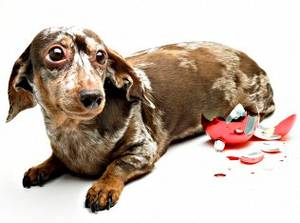Dealing With Dog Phobias

Many dogs do not like loud noises, but their reaction usually is only mild. A phobia is an intense, exaggerated response to a situation which an animal perceives as frightening.
Often a noise phobia starts out as a mild dislike of sound, for example, a thunderstorm which scared the dog as a puppy. It can spread to other unrelated noises, even seemingly innocuous ones, such as a door closing!
The dog's reaction to the noise phobia can include vocalizing, hiding or trying to escape. In the process it can hurt itself or damage your home by, for instance, destroying doors or fences while trying to escape from the noise. Dogs become very anxious that the noises will recur and this can affect their behavior. These dogs often also suffer from other disorders such as separation anxiety.
Many owners will try to calm a fearful dog by sitting with it and stroking it during the period of fear. While this seems a natural thing to do, it actually reinforces the fearful behavior by giving the dog a positive reward.
The dog needs to be trained not to be frightened of noises. Anxious dogs do not learn very well so many will initially need anti-anxiety medications to allow their behavior to be modified. This will require a visit to the veterinarian and a full assessment of the exact nature of the problem. Medications alone will not provide a solution but need to be combined with training to make a permanent change in the dog's behavior.
|
"Many owners will try to calm a fearful dog by sitting with it and stroking it during the period of
fear. While this seems a natural thing to do, it actually reinforces the fearful behavior by giving
the dog a positive reward."
|
There are milder treatments available which may assist in calming the dog. Dog Appeasement Pheromone (DAP) mimics the hormone secreted by the mother a few days after she has given birth to a litter of pups (to calm and settle them) and is a relaxing aroma for dogs of all ages. It is available in either a spray formulation or a diffuser which is plugged into an electrical outlet to release the pheromone for up to three months.
Reprogramming the dog's behavior should begin when the dog is calm, starting with teaching the dog to relax in the absence of any noises. Then reward this behavior to reinforce the idea that relaxation is a positive thing. There are doggy relaxation classes in some parts of the country, so ask your veterinarian about classes in your area.
When starting the training, try to avoid situations which will make the dog anxious. Make sure the dog has a consistent routine including a regular feeding time, a regular exercise time and so on. This reduces anxiety as he or she knows what will happen and when it will happen each day.
|
Dog toys and treats |
Pet Shed's most popular treats and toys to control or distract dogs:
|
The next step is crate training the dog to give it a place to go to sleep and to be calm. If you are not comfortable with a crate, use an alternative safe place which the dog can use to relax when it is quiet, so it will associate this place with positive experiences. It is a good idea if this is near the place the dog normally goes during the noise phobia, as the dog already regards this as a safer place to be.
If you are going to use a crate, leave the door open and put treats in it, along with favorite toys and perhaps a blanket the dog likes to sleep on. Allow it to go into the crate voluntarily and reward this. Play with the dog, give treats and encourage it to sleep in the crate. The relatively confined space will make the dog feel safer, like a little cave. Once it has learned that this is a safe, calm place, the dog will want to be here during times of fear.
Some dogs can be distracted from their noise phobia by an activity they love, such as throwing a ball. This makes them concentrate on the positive aspect of the game and disregard their anxiety.
A last resort is desensitization. Audio and video tapes can be purchased which will expose the dog to increasing levels of the scary noise, to desensitize it from being afraid of the sounds.
Dog trainers can also be of great value to assist with retraining the dog not to be afraid. The behavioral modification program should always be supervised by a veterinarian. These are difficult cases to manage. The dog will never truly be cured and the behavioral modification and reinforcement of the calm behavior will need to be continued throughout its life.
|
References
|
| Perry G. What Should I Do When I See a Noise Phobic Dog? Proceedings Australian Veterinary Association Conference 2006 |